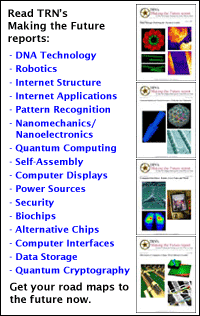
Optical quantum memory designed
By
Eric Smalley,
Technology Research NewsSince a landmark 2001 paper showed that quantum computers could be built using ordinary optical equipment like mirrors and beam splitters, researchers have been working on practical implementations.
Most designs call for using atoms or electrons as quantum bits, or qubits, because these types of quantum particles interact more readily than photons. Properties of the quantum particles that make up qubits can represent the 1s and 0s of digital information. A photon, for instance, can be polarized in two perpendicular directions, and one direction can represent 1 and the other 0.
But closely controlling small numbers of atoms or electrons requires complicated laboratory equipment, and these designs also require some means of transferring quantum information to photons in order to transmit information. Linear optical quantum computing overcomes these problems but requires a reliable method of briefly storing photonic qubits -- a major challenge considering the fleeting nature of photons.
Researchers at NASA's Jet Propulsion Laboratory have designed an optical quantum memory device capable of storing photonic qubits for use in all-optical quantum computers and quantum communications networks.
The researchers' quantum transponder could be used to make quantum repeaters that would extend the distances covered by emerging quantum cryptography systems. Quantum cryptography provides theoretically perfect security because eavesdroppers unavoidably disturb quantum information in detectable ways.
The transponder could also eventually be used in all aspects of quantum information processing, said Robert Gingrich, now a researcher at the California Institute of Technology. "We are aiming to design and ultimately build a complete quantum Internet using only linear optical elements," he said. "The quantum computers at each node and the quantum communication lines that connect them [would] all [be] made out of these simple resources."
The scheme calls for encoding pairs of quantum bits in sets of four photons in such a way that the two qubits can be read even if one of the four photons is lost. Qubits would be sent into a fiber loop and a simple quantum computer would correct for errors caused by photons being absorbed by the fiber. "Think of the fiber loop as a NASCAR race track and the qubit... as a race car. The quantum transponder or error-correcting box is the pit stop," said Gingrich. "The qubit degrades as it goes around the loop and so periodically it must be fixed at the pit stop."
The transponder includes a device that would generate single photons to replace lost photons.
The device could be used to extend quantum communications, including quantum cryptography, by linking multiple transponders in series. The transponders would allow quantum information to be transmitted over longer distances by simply correcting errors, unlike previous designs for quantum repeaters, which extend transmission distances by manipulating the weird quantum state of entanglement in pairs of atoms or subatomic particles. When particles are entangled, properties like polarization change in lockstep regardless of the distance between the particles. Pairs of entangled particles can be used to transmit information, but entanglement is a relatively fragile state.
Building practical optical quantum memory devices will require better photon detectors and devices that can reliably emit single photons on demand, said Gingrich.
The quantum transponder could be used in practical applications in five years, said Gingrich.
Gingrich's research colleagues were Pieter Kok, Hwang Lee, Farrokh Vatan and Jonathan Dowling. They published the research in the November 21, 2003 issue of Physical Review Letters. The research was funded by the National Security Agency (NSA), the Defense Advanced Research Projects Agency (DARPA), the National Reconnaissance Office, the Office of Naval Research (ONR), the National Research Council and NASA.
Timeline: 5 years
Funding: Government
TRN Categories: Quantum Computing and Communications; Physics
Story Type: News
Related Elements: Technical paper, "All Linear Optical Quantum Memory Based on Quantum Error Correction," Physical Review Letters, November 21, 2003
Advertisements:
April 21/28, 2004
Page One
Material grabs more sun
Spoke polarization tightens focus
Molecule makes electric motor
Optical quantum memory designed
Briefs:
Printer writes micro 3D objects
Tiny rotors spin into place
Nanotube forms drive shaft
Photons teleported six kilometers
Magnets align nanotubes in resin
Sturdy quantum crypto proposed
News:
Research News Roundup
Research Watch blog
Features:
View from the High Ground Q&A
How It Works
RSS Feeds:
News
Ad links:
Buy an ad link
| Advertisements:
|
 |
Ad links: Clear History
Buy an ad link
|
TRN
Newswire and Headline Feeds for Web sites
|
© Copyright Technology Research News, LLC 2000-2006. All rights reserved.